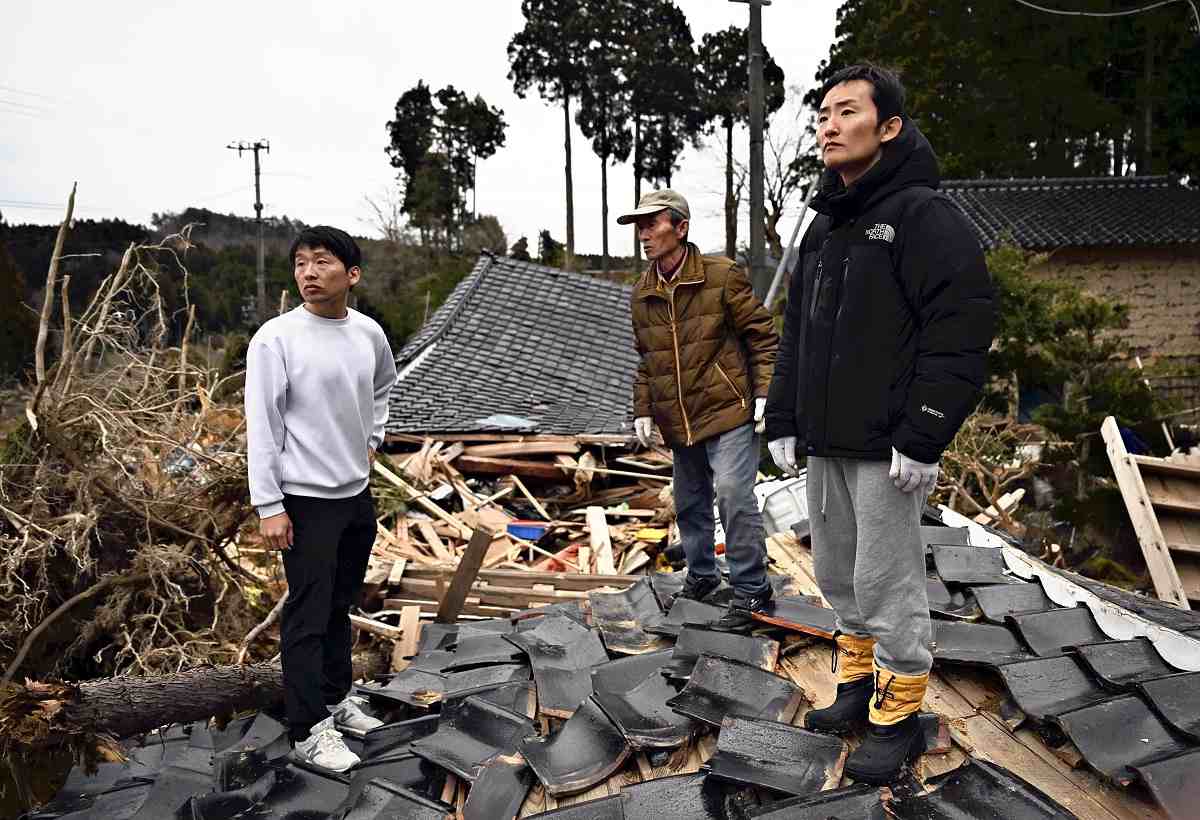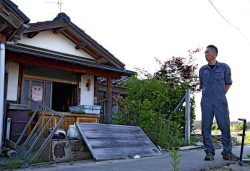Noto Peninsula Earthquake – 3 Months Later / Japan’s Quake-Hit Region Suffer Serious Population Outflow; Concerns Grow over Future Vitality of Region

Shingo Koie, right, looks at the landscape changed by the earthquake as he visits his destroyed home in Suzu, Ishikawa Prefecture, on March 28.
6:00 JST, April 4, 2024
How can Ishikawa Prefecture’s Noto region find a foothold for reconstruction following the Noto Peninsula Earthquake? This is the third and final installment of a series that examines some of the problems the area is facing.
***
Population outflow is rapidly progressing in four cities and towns in the Okunoto region of Ishikawa Prefecture that was severely damaged by the Noto Peninsula Earthquake on New Year’s Day.
The cities of Wajima and Suzu, and towns of Noto and Anamizu, with a total population of just under 60,000, had a total net outflow of 1,582 people from January through March, with the number increasing each month.
The figure is 3.8 times that of the same period last year.
The question is whether people will return to the municipalities and whether their communities can be revitalized and maintained again. Reconstruction is a race against the clock.
Shingo Koie, 40, who ran a chiropractic clinic in Suzu decided to leave his hometown.
A hill behind his house collapsed during the earthquake, sending an avalanche of earth and sand onto his house in the city, destroying it.
His 3-year-old son was seriously injured, breaking his collarbone, and his clinic was badly damaged.
Since March, Koie has been helping his 42-year-old brother, who runs a chiropractor clinic in Kyoto. He plans to move to Kanazawa in the summer with his wife, 40, and two children and open a chiropractic clinic there as that is his wife’s hometown.
He made this decision after much consideration. He opened his clinic in 2017 in Suzu, hoping to support the well-being of the Okunoto region after returning to the city from outside the prefecture when his mother became ill.
The clinic attracted regular customers. However, Koie was not sure if he would be able to continue running it because many residents evacuated outside Suzu after the earthquake.
His wife’s words also influenced his decision: “Our children are very young, and we’re afraid of aftershocks.”
There are concerns that the exodus of the child-rearing generation will continue if there are no places for them to live and work. Also, even before the earthquake, the four cities and towns had been experiencing severe depopulation.
According to the national census, from 2010 to 2020 the population decreased 1.5% nationwide. Ishikawa Prefecture shrank 3.2% in that time, with Wajima dropping 17.6% and Suzu 20.7%. The number of people age 65 and over is around 50% in the four municipalities, about 20 percentage points higher than the national average.
Population decline is also an issue in areas affected by the 2011 Great East Japan Earthquake. As of March, the population of 12 coastal municipalities in Iwate Prefecture fell 23.1% from March 2011 levels, more than double the 10.3% decline in inland areas. In Otsuchi in the prefecture, which saw a 33% decline, the number of people under 30 dropped by about 45%.
“The younger people are, the less likely they are to return if they don’t have a job,” an Otsuchi municipal government official said. “We needed to rebuild housing and town functions more quickly.”
In Wajima, 45% of those who moved out of the city in January and February were under 30 years old. Mayor Shigeru Sakaguchi did not hide his impatience, saying, “I hope the prefectural government will do its best to promote the construction of emergency temporary housing.”
A total of 1,440 temporary housing units have been completed in the four cities and towns, but the construction of public housing for disaster victims has yet to begin.
Notosaku Co., a construction company in Suzu, spent ¥15 million in late February to build eight prefabricated houses near the company for its employees.
“If there are no people left, restoration and reconstruction will not happen,” said Notosaku President Kazunobu Myojo, 57.
The central government and Ishikawa Prefecture have established the “Nariwai reconstruction assistance grant” to support the restoration of facilities of small and midsize enterprises affected by the disaster.
However, only 27 applications were received in the first round, and only six applications with complete documentation were accepted. Of these, only one was for a company in the Okunoto region.
The application process was complicated and, in addition, some people were wondering whether they should continue to run their business, said a senior prefectural government official.
“It is essential to restore the industries that support the region’s vitality to stop the outflow of the population,” said University of Tokyo Prof. Miho Ohara, who specializes in disaster risk reduction.
“Support for procurement and tourism from outside the affected areas is also important. It will be crucial for the governments and residents to work together to determine what kind of reconstruction, including such support, should be pursued, and to present [a reconstruction plan] as soon as possible,” she said.
"Society" POPULAR ARTICLE
-

M4.9 Earthquake Hits Tokyo, Neighboring Prefectures
-

Israeli Tourists Refused Accommodation at Hotel in Japan’s Nagano Pref., Prompting Protest by Israeli Embassy and Probe by Prefecture
-

M7.5 Earthquake Hits Northern Japan; Tsunami Waves Observed in Hokkaido, Aomori and Iwate Prefectures
-

Tsukiji Market Urges Tourists to Avoid Visiting in Year-End
-

M5.7 Earthquake Hits Japan’s Kumamoto Pref., Measuring Upper 5 Intensity, No Tsunami Expected
JN ACCESS RANKING
-

Keidanren Chairman Yoshinobu Tsutsui Visits Kashiwazaki-Kariwa Nuclear Power Plant; Inspects New Emergency Safety System
-

Tokyo Economic Security Forum to Hold Inaugural Meeting Amid Tense Global Environment
-

Imports of Rare Earths from China Facing Delays, May Be Caused by Deterioration of Japan-China Relations
-

University of Tokyo Professor Discusses Japanese Economic Security in Interview Ahead of Forum
-

Japan Pulls out of Vietnam Nuclear Project, Complicating Hanoi’s Power Plans
























